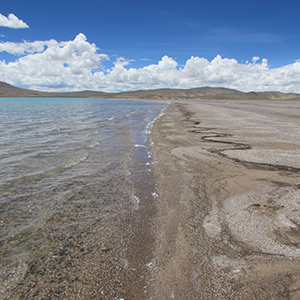Sub-fossil chironomids as indicators of hydrological changes in the shallow and high-altitude lake Shen Co, Tibetan Plateau, over the past two centuries

Accepted: 20 July 2022
Supplementary: 178
HTML: 130
All claims expressed in this article are solely those of the authors and do not necessarily represent those of their affiliated organizations, or those of the publisher, the editors and the reviewers. Any product that may be evaluated in this article or claim that may be made by its manufacturer is not guaranteed or endorsed by the publisher.
Authors
Understanding climate and monsoonal dynamics on the Tibetan Plateau is crucial, as recent hydrological changes, evidenced by rising lake levels, will be accelerated by current global warming and may alter aquatic habitats and species inventories. This study combines chironomid assemblages with sedimentological, mineralogical and geochemical data of a short sediment core (37.5 cm) from the high-altitude (> 4,733 m asl), saline (9 g L-1) and shallow (~5 m water depth) Shen Co, located in the southern part of the central Tibetan Plateau. The predominantly littoral, species-poor (10 chironomid morphotypes) chironomid assemblages are dominated by salt-tolerant taxa, that are highly sensitive to lake level fluctuations and macrophyte vegetation dynamics, making them ideally suited for tracking lake level changes over time. Results indicate a period (from ca. 1830 to 1921 CE) of drier conditions with low runoff and high evaporation rates in the Shen Co catchment, as indicated by a dominance of low-Mg calcite and dolomite and increased Ca/Fe and Sr/Rb ratios. This resulted in a decline in lake levels, an increase in salinity and the periodic occurrence of desiccation events at the sampling site. The first chironomid morphotype to appear after the dry period is Acricotopus indet. morphotype incurvatus, which indicate still low (<2 m) but rising lake levels after 1921 CE due to increasing runoff and a lower evaporation/precipitation ratio, as reflected by coarser grain size, higher quartz content and increased TN, TOC and Al/Si ratios. A replacement of A. indet. morphotype incurvatus by Procladius is observed as lake level rise continued after 1950 CE. The highest lake level is proposed for the period since 2006 CE. From 1955 to 1960 CE and from 2011 to 2018 CE, the presence of the phytophilic taxon Psectrocladius sordidellus-type supported abundant macrophyte growth. These changes are consistent with climate reconstructions from the northern and central Tibetan Plateau, indicating warmer and wetter climate conditions since the beginning of the 20th century, which have led to an increase in lake level in a number of Tibetan lakes. Our study specifically highlights 1920 and 1950 as years with enhanced precipitation. This can be attributed to the strong, with overlapping multidecadal cycles of Westerlies and monsoon systems. This study demonstrates the significance of studying small, shallow lakes, as they frequently contain aquatic communities that respond more rapidly to the changes in the lake system. In addition, this study expands our understanding of the ecology of Tibetan chironomid morphotypes, highlighting this group’s potential as paleolimnological proxies for investigating past environmental and climatic changes.
Edited by
Diego Fontaneto, CNR-IRSA Water Research Institute, Verbania, ItalySupporting Agencies
Nam Co Observation and Research Station (NAMORS), International Research Training Group, Deutsche Forschungsgemeinschaft (DFG grant 317513741 / GRK 2309), Open Access Publication Funds of the Technische Universität BraunschweigHow to Cite

This work is licensed under a Creative Commons Attribution-NonCommercial 4.0 International License.
Similar Articles
- Juha NIEMISTÖ, Heidi HOLMROOS, Jukka HORPPILA, Water pH and sediment resuspension regulating internal phosphorus loading in a shallow lake – field experiment on diurnal variation , Journal of Limnology: Vol. 70 No. 1 (2011)
- Alberto BARBIERI, Rosario MOSELLO, Recent trends in chemistry and mass budget of a high altitude lake in the southern Alps (Laghetto Inferiore, Canton Ticino, Switzerland) , Journal of Limnology: Vol. 59 No. 2 (2000)
- Michaela M. Salcher, Same same but different: ecological niche partitioning of planktonic freshwater prokaryotes , Journal of Limnology: Vol. 73 No. s1 (2014): Limnology in the 21st Century: celebrating 75 years of ecological research in Pallanza
- Silvana GALASSI, Pietro VOLTA, Alcide CALDERONI, Licia GUZZELLA, Cycling pp'DDT and pp'DDE at a watershed scale: the case of Lago Maggiore (Italy) , Journal of Limnology: Vol. 65 No. 2 (2006)
- Walter AMBROSETTI, Luigi BARBANTI, Temperature, heat content, mixing and stability in Lake Orta: a pluriannual investigation , Journal of Limnology: Vol. 60 No. 1 (2001)
- Matti Leppäranta, Elisa Lindgren, Lijuan Wen, Georgiy Kirillin, Ice cover decay and heat balance in Lake Kilpisjärvi in Arctic tundra , Journal of Limnology: Vol. 78 No. 2 (2019)
- Juan Manuel MEDINA-SÁNCHEZ, Manuel VILLAR-ARGAIZ, Pedro SÁNCHEZ-CASTILLO, Luis CRUZ-PIZARRO, Presentación CARRILLO, Structure changes in a planktonic food web: biotic and abiotic controls , Journal of Limnology: Vol. 58 No. 2 (1999)
- Robert Hall, The palaeogeography of Sundaland and Wallacea since the Late Jurassic , Journal of Limnology: Vol. 72 No. s2 (2013): Freshwater Invertebrates of Southeast Asia
- Alessandra PUGNETTI, Roberta BETTINETTI, Biomass and species structure of the phytoplankton of an high mountain lake (Lake Paione Superiore, Central Alps, Italy) , Journal of Limnology: Vol. 58 No. 2 (1999)
- Robert J. Morley, Cenozoic ecological history of South East Asian peat mires based on the comparison of coals with present day and Late Quaternary peats , Journal of Limnology: Vol. 72 No. s2 (2013): Freshwater Invertebrates of Southeast Asia
<< < 55 56 57 58 59 60 61 62 63 64 > >>
You may also start an advanced similarity search for this article.
-
Paula Echeverría‐Galindo, Sonja Rigterink, Julieta Massaferro, Liseth Pérez, Bernd Wünnemann, Philipp Hoelzmann, Wengang Kang, Nicole Börner, Anja Schwarz, Andreas Laug, Ping Peng, Junbo Wang, Liping Zhu, Antje SchwalbJournal of Quaternary Science : 2023
-
Marco Bertoli, Gianguido Salvi, Rachele Morsanuto, Elena Pavoni, Paolo Pastorino, Giuseppe Esposito, Damià Barceló, Marino Prearo, Elisabetta PizzulDiversity : 2024

 https://doi.org/10.4081/jlimnol.2022.2077
https://doi.org/10.4081/jlimnol.2022.2077





